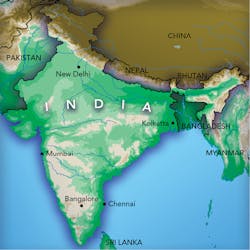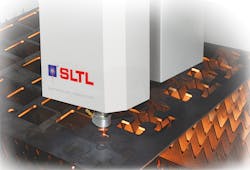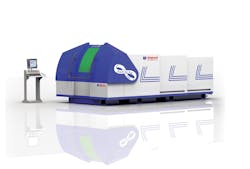Times are changing and so is the world’s outlook towards India, as the world is looking to India as the next manufacturing hub after China. Therefore, it’s important to understand how the laser market is and how it will grow in the coming year.
The last year and half has brought lot of changes in government policy, with steps such as demonetization and then implementation of Goods and Service Tax (GST). These changes had an effect on the laser business, as it took time to understand the implication. There was a quarter or so where business took a back seat, especially after GST implementation. However, with a better understanding of GST and GST rates slashed to 18% from 28%, it looks that this policy will boost laser industry growth.
Looking into the market and its driving forces, it’s known that the laser market is primarily dominated by the sheet metal industry, which in turn is driven by the automotive sector and then the fabrication industry. Laser marking and cutting are the two dominating markets for lasers in India right now, while laser welding, cladding, hardening, micromachining, and surface treatment are still insignificant. Note that we are not discussing other markets such as medical, solar, optical communication, and sensors, the latter of which is a topic for discussion sometime later.
Regarding laser marking, as prices have come down heavily (with Chinese-imported 20 W fiber laser machines now at <$5000 and <$3000 USD for CO2-based systems), it has become more like a commodity, as they are now readily available locally, from stock. However, there is still demand for high-quality, locally made machines by local integrators, as well as imported machines from international players such as Videojet, Trumpf, Coherent, Keyence, and others. I believe that the precision and quality of the machines made by local integrators such as Sahajanand, Agile, Spinks, and SIL are on par with these international players—however, the barrier has not broken wherein they can complete with these companies.Laser cutting
The number of laser cutting machines in the Indian market is growing rapidly. As per my discussion with leading suppliers Sahajanand Laser Technology (FIGURE 1), Suresh Indu Pune, Laser Technology, Angel CAD CAM, Mehta CAD CAM, Sigma Mechatronics, ProLastec Pune, and others, the overall market was between 300 and 400 machines for 2017. In 2018-2019, it may reach 600–800 lasers for cutting machines. More than half of this market will be for cost-effective machines manufactured in China (for low- and high-power fiber lasers from companies such as HSG [FIGURE 2], DNE, and Bodor), with the rest shared by local integrators and big international players such as Trumpf, Amada, Bystronic, LVD, Prima Power, and Mazak Optonics.After discussions with the above-mentioned companies, the reason for the growth of the laser market in India can be attributed to the following:
1. The automotive market is growing at a double-digit growth rate and is the driving force for the sheet metal industry, thereby contributing significantly to the growth of lasers.
2. The manufacturing fabrication sector, especially the thin sheet metal industry (<5 mm) for kitchenware, lifts, interior designers, and other such applications, is also contributing to the growth. Earlier, this sector was outsourcing their jobs because of the high cost of the lasers and their maintenance (earlier systems were CO2 laser-based and expensive). However, with the no-maintenance fiber laser cost coming down to <$50,000 for a 1 kW fiber laser system, these companies can now afford to have an in-house machine.The number of job shops has increased, as new job shops are being set up outside of cities in smaller places. Also, established job shops that were using a high-power CO2 laser cutting machine are purchasing a fiber laser machine for cutting thinner metal (<5 or 10 mm). The reason for job shops flourishing is that large companies outsource rather than having an in-house machine for production, as they don’t want to make an effort to run a machine for production, keeping a dedicated technically trained staff to run the laser machine and still not be sure they can get the desired quality and production rate. Instead, they don’t mind paying a little extra while eliminating the hassle and ensuring timely delivery of the material with the desired quality.
3. The low thickness sheet metal market, which was earlier done by the turret punch, is now being taken over by low-power laser cutting systems (mainly 500 or 1 kW). However, the trend is people going to 1 and 1.5 kW instead of 500 W.
4. Another factor is the increase in the number of distributors/integrators. Many local companies that were earlier making or selling plasma cutting, CNC, or marking machines have ventured into selling/assembling imported Chinese laser cutting machines. The number of such distributors is growing every year.
An interesting thing to note is that even though there is a significant growth in number of laser cutting machines in terms of volume, if you see the business in terms of revenue, this number does not seem to be growing at the same rate. This thought has been echoed by Maulik Patel from Sahajanand Laser Technology (FIGURE 3). This causes me, and others, to think whether it’s an actual growth of the laser market in India. However, it depends on the individual’s perspective.The reason for growth of the laser market is lower prices for machines, which are continuing to go down. It seems this trend will go on for next few years until the market stabilizes at a price point.
The future
Looking into the laser market for the coming years, it seems that laser cutting will still rule the market (with 1–1.5 kW as baseline machines, and also other higher powers). However, we may have different markets contributing to growth in the long run. For example, because of the Indian Government’s Make in India initiative, the thrust is on setting up local manufacturing sectors such as defense and aerospace, where joint ventures are done between leading world companies and Indian companies such as TATA, Reliance, L&T, and Mahindra. This will result in demand for laser systems for cutting, welding, cladding, micromachining, and shot peening applications, while medical, packaging, and other sectors will have their own laser applications.
The high-power laser market (>2–3 kW and above) will be growing, with these being used in applications for cutting, welding, cladding, and heat treatment. High-power laser welding will grow with expansion in automotive and other sectors, while low-power pulsed YAG/fiber laser welding systems, which are steadily growing for different applications such as mold repair and battery welding, will continue to grow as manufacturing activity picks up in future.
The surface treatment (cladding and heat treatment) market, which is a steady market mainly dominated by Laserline, has not grown as expected because of conventional coating methods like plasma transferred arc (PTA) being a cheaper and proven technology for most of the applications. If this market has to grow for lasers, then companies need to identify their specific applications, and prove and show the advantages to end customers who need to learn how a laser can really benefit them in longer run by saving costs in comparison to PTA, even if the initial cost of investment is high. However, this needs time for a lot of understanding, teaching, and educating end customers to take this market to its full potential, as has been done in Europe and the US.
Another driving factor in the coming years will be additive manufacturing, 3D printing, and hybrid manufacturing, which will greatly utilize lasers for manufacturing in all industrial sectors, including the automotive, aerospace, medical, jewelry, and tooling industries.
Growth in lasers for research will be steady, as new Indian Institutes of technology, nanocenters, and centers of excellence are being opened and funding for newer technology such as nano, solar, and biophotonics are funded by the Government. However, more emphasis is on private partnership for some portion of the funding of the total project cost, so as to have result-oriented research.
A sector driving laser sales the world over is OLED displays, microelectronics, and semiconductors, which are right now not present in India. But, as is said, “the youth is the hope of our future”—with more than 60% of the population of India aged under 35, it looks like the future belongs to India. However, this growth will come with its own set of challenges, such as shortage of trained manpower, application experts, and safety issues, which I believe can be resolved as the time comes.



